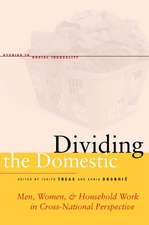The Dynamics of Rules: Change in Written Organizational Codes
Autor James March, Martin Schulz, Zhou Xueguangen Limba Engleză Paperback – 31 iul 2000
Written rules in formal organizations are distinctive elements of organizational history; they shape organizational change and are in turn shaped by it. These rules are created, revised, and eliminated in ways that leave historical traces, and they have a visibility and durability that elude non-written rules. They thus provide rich data for an empirical probe into the dynamics of organizational history.
This study uses qualitative and quantitative data from the history of a specific organization, Stanford University, to develop speculations about the ways in which written rules change. It contributes both to a theory of rules and to theories of organizational decision-making, change, and learning. Organizations respond to problems and react to internal or external pressures by focusing attention on existing and potential rules. The creation, modification, or elimination of a rule, then, is a response to events in the outside environment (such as new government regulations) or to events within the organization (such as alterations in internal government structures).
The authors elaborate a simple set of ideas about written rules and their dynamics, emphasizing the interplay among periodic major shocks to the system from outside, experiences with individual rules as they age and are revised, and the spread of effects through an interconnected set of rules. It is a story in which changes introduced in one part of a rule system create adjustments in other parts, including the same rule later in time, as the consequences of the changes are experienced and as rule-making attention is mobilized, satiated, and redirected. These processes involve the full panoply of political negotiation, symbolic competition, discussion, and problem solving that are typical of organizational decision making.
This study uses qualitative and quantitative data from the history of a specific organization, Stanford University, to develop speculations about the ways in which written rules change. It contributes both to a theory of rules and to theories of organizational decision-making, change, and learning. Organizations respond to problems and react to internal or external pressures by focusing attention on existing and potential rules. The creation, modification, or elimination of a rule, then, is a response to events in the outside environment (such as new government regulations) or to events within the organization (such as alterations in internal government structures).
The authors elaborate a simple set of ideas about written rules and their dynamics, emphasizing the interplay among periodic major shocks to the system from outside, experiences with individual rules as they age and are revised, and the spread of effects through an interconnected set of rules. It is a story in which changes introduced in one part of a rule system create adjustments in other parts, including the same rule later in time, as the consequences of the changes are experienced and as rule-making attention is mobilized, satiated, and redirected. These processes involve the full panoply of political negotiation, symbolic competition, discussion, and problem solving that are typical of organizational decision making.
| Toate formatele și edițiile | Preț | Express |
|---|---|---|
| Paperback (1) | 301.05 lei 6-8 săpt. | |
| Stanford University Press – 31 iul 2000 | 301.05 lei 6-8 săpt. | |
| Hardback (1) | 885.31 lei 6-8 săpt. | |
| Stanford University Press – 31 iul 2000 | 885.31 lei 6-8 săpt. |
Preț: 301.05 lei
Nou
Puncte Express: 452
Preț estimativ în valută:
57.60€ • 60.15$ • 47.57£
57.60€ • 60.15$ • 47.57£
Carte tipărită la comandă
Livrare economică 15-29 aprilie
Preluare comenzi: 021 569.72.76
Specificații
ISBN-13: 9780804739962
ISBN-10: 080473996X
Pagini: 248
Dimensiuni: 152 x 229 x 20 mm
Greutate: 0.36 kg
Ediția:1
Editura: Stanford University Press
Colecția Stanford University Press
ISBN-10: 080473996X
Pagini: 248
Dimensiuni: 152 x 229 x 20 mm
Greutate: 0.36 kg
Ediția:1
Editura: Stanford University Press
Colecția Stanford University Press
Recenzii
"In developing an elegant and sophisticated theory of how and why organizational rules change, the authors have created an entirely new field of organizational research. I know of no other general theory on the rise, evolution, and demise of rules, and I have never seen such a rich longitudinal dataset on rules." —Frank Dobbin, Princeton University
"This is an important book. . . . It outlines an emerging theory of the dynamics of organizational rules that enriches many other perspectives on the functioning of organizations. . . . Future discussions of institutionalization, organization-environment adaptation, organizational learning, organizational change, and the effect of contextual influences on individual behavior will benefit from consideraiton and inclusion of the themes presented here."—Personnel Psychology
Notă biografică
James G. March is Professor Emeritus of Political Science, Sociology, Education, and International Management at Stanford University. Martin Schulz is Assistant Professor of Business Administration at the University of Washington. Xueguang Zhou is Associate Professor of Sociology at Duke University.
Textul de pe ultima copertă
“In developing an elegant and sophisticated theory of how and why organizational rules change, the authors have created an entirely new field of organizational research. I know of no other general theory on the rise, evolution, and demise of rules, and I have never seen such a rich longitudinal dataset on rules.” —Frank Dobbin, Princeton University
“This is an important book. . . . It outlines an emerging theory of the dynamics of organizational rules that enriches many other perspectives on the functioning of organizations. . . . Future discussions of institutionalization, organization-environment adaptation, organizational learning, organizational change, and the effect of contextual influences on individual behavior will benefit from consideraiton and inclusion of the themes presented here.”—Personnel Psychology
“This is an important book. . . . It outlines an emerging theory of the dynamics of organizational rules that enriches many other perspectives on the functioning of organizations. . . . Future discussions of institutionalization, organization-environment adaptation, organizational learning, organizational change, and the effect of contextual influences on individual behavior will benefit from consideraiton and inclusion of the themes presented here.”—Personnel Psychology



















